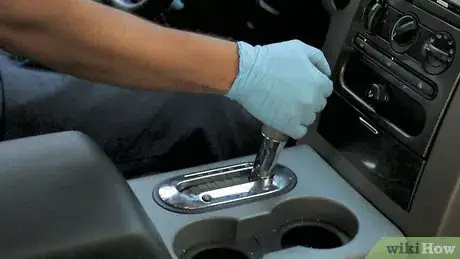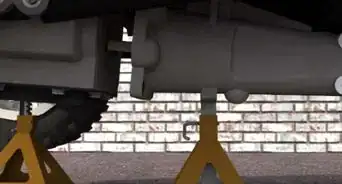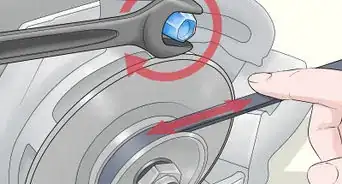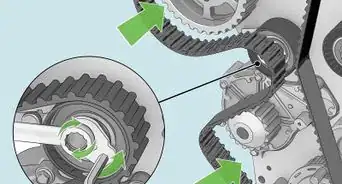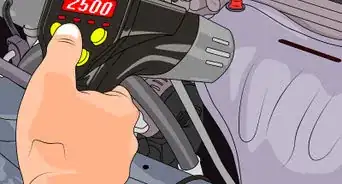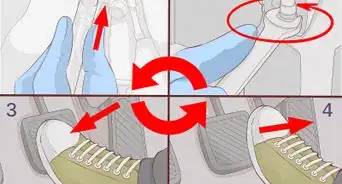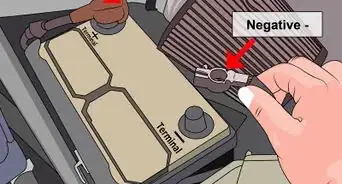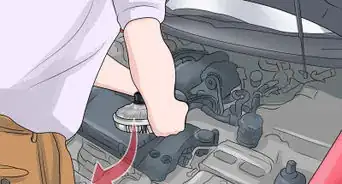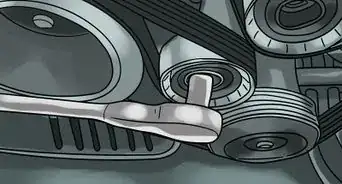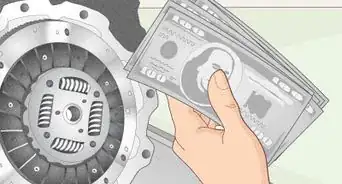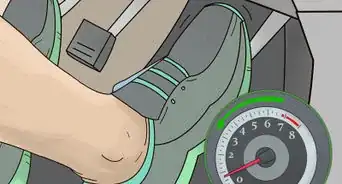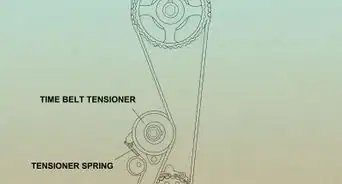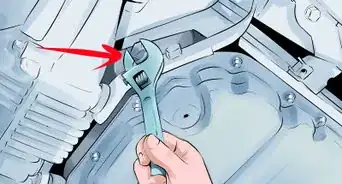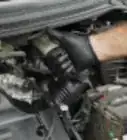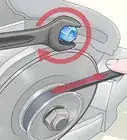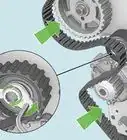This article was co-authored by Ed Beery. Ed Beery is an Automotive Specialist and the Owner of InTechgrity Automotive Excellence based in Denver, Colorado. With more than eight years of experience, he specializes in providing maintenance and repair services for both individuals and companies. Ed and the InTechgrity Automotive Excellence Team are approved by the American Automobile Association (AAA) for repairs and are Automotive Service Excellence (ASE) certified.
wikiHow marks an article as reader-approved once it receives enough positive feedback. This article received 13 testimonials and 89% of readers who voted found it helpful, earning it our reader-approved status.
This article has been viewed 908,203 times.
Transmission fluid is a slick, oily substance that keeps the transmission of your car lubricated. The type of transmission fluid you need depends on the make and model of your vehicle and whether you drive a car with an automatic or manual transmission. Check your owner's manual and follow directions for checking fluid level and fill procedures. Some manufacturers do not have a normal dipstick for checking and filling. The below steps are for the most common transmission check and fill procedures.
Steps
How to Check Your Fluid
-
1Start your car. In order to get an accurate transmission fluid reading, you will need to check the level while your transmission is running and the fluid is warm. Keep your car in park with the handbrake on while you check the transmission fluid. Note that some vehicles are checked in the neutral position. Reference your owner's manual for the proper position of your car's shifter.
- If you've just finished driving your car for 30 minutes or longer, it's a good idea to let your engine idle a few minutes before you check the trans fluid.[1] This will allow the temperature of the fluid to normalize.
- Note that some cars may also have a "cold" reading on the transmission dipstick. Even if this is the case in your vehicle, you should still start your engine and get the transmission fluid heated up in order to get an accurate reading.
-
2Without actually driving the car, depress the brake and run the transmission through all the gears, including Reverse and Overdrive. If you check the transmission fluid cold — i.e., not having driven anywhere and not having run through all the transmission gears — inspection of the transmission dipstick will give you an inaccurate reading. It will appear as if you have far too much transmission fluid in your car. To avoid this, cycle through all the gears in your car to help circulate the transmission fluid evenly.Advertisement
-
3Park your car on a flat, horizontal surface. This will help assure that you get an accurate reading.
-
4Open the hood and locate your transmission dipstick.[2] Remember to set the parking brake, especially if you're leaving the car in neutral. On some cars, it is easy to mistake the transmission dipstick for the crankcase oil dipstick, so make sure you are clear on the location of your transmission.
- Look towards the back of the engine, near the firewall. This is where the transmission is located on most cars with rear-wheel drive.[3]
- On cars with front-wheel drive, the transmission dipstick is usually located near the front of the engine, connected to the transaxle. This isn't universally true, however, so you should look at your owner's manual or for labels around and on the dipstick to positively identify that it is the right dipstick.[4]
-
5Pull the dipstick out and wipe it with a rag. This will help give you an accurate reading.
-
6Stick the dipstick back into the transmission fluid and lift it out again for your reading.[5] You should now be able to see what level your transmission fluid reaches. Remember to compare your fluid level to the "hot" marking on the transmission fluid dipstick.
How to Add the Fluid
-
1Keep your engine idling with the transmission in park and the parking brake set. Your car's engine should be running when you add fluid to the transmission, but you should have the transmission in park and the handbrake activated for safety.
-
2Check the owner's manual for instructions on selecting the correct transmission fluid for your vehicle. Your owner's manual will tell you what type of transmission fluid to us and whether there are special instructions for adding fluid.
- The transmission dipstick itself might also tell you what kind of transmission fluid the transmission takes. Note that there are several different kinds, each with specifications that make it favorable for that engine's transmission.
- Also look for instructions on how frequently to change your transmission fluid. While you can add fluid when it gets low, many car manufacturers recommend a transmission fluid change every 30,000 to 100,000 miles (48,000 to 161,000 km) depending on the make and model of your car.
-
3Place a funnel in the dipstick hole of the transmission. Most cars need a longer "transmission fluid" funnel.
-
4Pour the correct fluid slowly into the funnel. Add a little at a time so you do not overfill. How much transmission fluid do you add to your vehicle? It depends on what you're doing:
- Are you topping off fluid level? If you notice the transmission fluid is a little low on the dipstick, start with a half a quart to a quart of transmission fluid. Recheck the level and add ¼ quart (or less) at a time until the level is up to the full or max mark.
- Are you doing a transmission service where you drop the pan and replace the filter? This kind of service usually needs 4 to 5 quarts of transmission fluid in order to replace what was lost in the pan.
- Are you replacing all the transmission fluid? It could take anywhere from 9 to 13 quarts of transmission fluid to replace the old transmission fluid.
-
5Depress the brake and run the transmission through its gears with the car idling. This will help circulate the transmission fluid and make sure you're getting the correct reading.
-
6Check the fluid level once more. You may not need to add more transmission fluid but, if you do, you'll want to add the fluid a little at a time. At this point, most vehicles will not need more than 1 pint (0.5 liter) of additional fluid.
-
7Return the dipstick to the transmission dipstick sleeve and make sure it is seated well. You may need to turn it until it locks or press down a latch on the top of the dipstick to lock it into place.
Warnings
- Make sure you do not pour the wrong type of fluid into your transmission. Doing so can damage your vehicle and the repairs will likely not be covered by your warranty.⧼thumbs_response⧽
- If you do not flush your transmission at the recommended intervals. you risk your transmission wearing out prematurely. If you are hard on your transmission or regularly pull heavy loads, consider changing the transmission fluid more frequently.⧼thumbs_response⧽
- Consider having your mechanic look at your transmission if you notice yourself adding fluid regularly. If you regularly lose transmission fluid, you may have a leak.[7]⧼thumbs_response⧽
Things You'll Need
- Rag
- Transmission fluid
- Owner's manual
- Transmission funnel
References
- ↑ http://community.cartalk.com/discussion/2290423/how-hot-should-my-engine-be-to-check-the-transmission-fluid-on-my-2000-subaru-outback
- ↑ Ed Beery. Automotive Specialist. Expert Interview. 19 November 2021.
- ↑ http://www.dummies.com/how-to/content/how-to-check-automatic-transmission-fluid.html
- ↑ http://www.dummies.com/how-to/content/how-to-check-automatic-transmission-fluid.html
- ↑ Ed Beery. Automotive Specialist. Expert Interview. 19 November 2021.
- ↑ Ed Beery. Automotive Specialist. Expert Interview. 19 November 2021.
- ↑ Ed Beery. Automotive Specialist. Expert Interview. 19 November 2021.
About This Article
To add transmission fluid to your vehicle, first check your owner’s manual to be sure you know what kind of transmission fluid to use. When you’re ready to add the fluid, keep your engine idling and put the transmission in park. Make sure to set the hand brake for safety. Remove the dipstick from the transmission fluid reservoir and insert a funnel into the hole. Pour the fluid into the funnel slowly, taking care not to overfill the reservoir. The amount of fluid you need will depend on whether you’re topping off the fluid or completely replacing it after draining the old fluid. Then, push down on the brake pedal to help distribute the fluid through the car’s gears while the engine is still idling. Check the transmission fluid level one more time using a dipstick and add a little more to top off the reservoir if necessary. Put the dipstick or cap back in place when you’re done.

